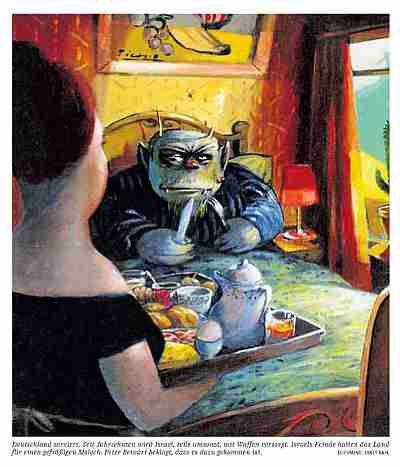Alongside a favorable review of two books that are highly critical of Israel, the German newspaper Süddeutsche Zeitung (SZ) ran a cartoon on July 2 depicting Israel as a voracious Moloch, the deity to whom ancient Canaanites sacrificed children. The caption reads, “Germany is serving. For decades, Israel has been provided with weapons, in part for free. Israel’s enemies see the country as a voracious Moloch. Peter Beinart laments that it has come to this.” (Beinart is referenced because his book, The Crisis of Zionism, is one of those reviewed.)

Unlike other anti-Semitic cartoons, in this case the artist bears no responsibility as the drawing was originally created for a gourmet magazine, having nothing in particular to do with Jews or Israel. The artist, Ernst Kahl, is quoted in the German Jewish newspaper, Judische Allgemeine, as saying he is “appalled” that his drawing was used in this context. Indeed it is the context that creates the issue.
SZ editors have printed two statements on the subject. The first cites the controversy and explains that “only the enemies of Israel see Israel in a way that is similar to the monster pictured. In addition, the State of Israel is not to be equated with Judaism.” The assertion that only the enemies of Israel see it this way is absurd, as the bigoted message denigrating Israel is unambiguous and could obviously fuel misunderstanding and animosity in unsuspecting readers. Further, denying the link between Israel and Judaism is ridiculous.
The SZ statement goes on to acknowledge that it would have been better to select another picture, if only to allow people to focus on the anti-Israel article itself.
The second statement by the paper concedes only that readers could have misunderstood the image and includes a weakly-worded quasi-apology, “The Süddeutsche Zeitung regrets that it could come to such misunderstandings. The publication of the drawing in this context was a mistake.”
Both the Simon Weisenthal Center and the American Jewish Committee have been highly critical of the SZ’s use of the image in this manner, with AJC Berlin Director Deidre Berger stating, “A German newspaper publishing age-old anti-Semitic imagery of Jews is simply outrageous. Cartoons that employ vicious stereotypes to criticize the Israeli government are insidious, and contribute to promoting hatred of Jews and Israel.” The AJC has filed a complaint with the German Press Council, saying that publishing this cartoon in this context is a major violation of press standards for ethical and balanced reporting and declaring that “The SZ explanation is totally unsatisfactory.”
Not only do SZ editors shamefully disregard German media’s troubling history where Jews are concerned, the fact that editors chose to portray Israel with this image, made hateful in this context, suggests an animus toward the Jewish state that overrides any reasonable understanding of facts.
Far from being a voracious monster gobbling up territory, Israel has repeatedly ceded territory in largely-failed efforts to achieve peace with its neighbors. Israel has withdrawn from Sinai, southern Lebanon, Gaza, and portions of the West Bank, and more often than not gotten in return lawlessness and terrorism, rockets, missiles and suicide bombers, Hezbollah, Hamas, Islamic Jihad, the al-Aqsa Martyrs Brigade and an intifada.
As opinion shapers, it is incumbent upon the editors of SZ, Germany’s largest circulation broadsheet reaching 1.1 million readers daily, to lead the way in combating the ominous resurgence of anti-Semitism in Europe. Instead of fomenting it, the newspaper should examine this age-old hatred and its current form, Israel-hatred. It should promote the facts about Israel and help dispel the unwarranted hostility triggered by lies and bias.
Fueled by distorted coverage of Israel found in media throughout Europe, a new study reveals that anti-Semitism is on the rise on the continent. Twenty six percent of Jews there have suffered anti-Semitic harassment in the past year, 34% in the past five years, 7% were physically hurt or threatened in the past five years, and 5% reported property intentionally vandalized because they are Jewish.
Recently, the German parliament passed a resolution committing the country to renewed action against anti-Semitism, “a special form of group-oriented xenophobia,” condemning Israel-related anti-Semitism, emphasizing the special relationship between Germany and Israel, and stressing that solidarity with Israel is essential to the German state.
If Germany is to live up to this admirable commitment, both political leaders and thought leaders must fully dedicate themselves to the effort.
In the wake of the considerable outcry over its publication of the Moloch cartoon, SZ has issued an additional statement. Editor-in-chief Kurt Kister acknowledges the firestorm of protest, again stresses that the cartoon was meant only to depict how Israel’s enemies perceive the Jewish state, but now adds that the cartoon was an unsuccessful attempt to denounce stereotypes. In addition to these explanations, there is also an apology. The statement translates (roughly) to:
Unsuccessful Use of Clichés
There was significant criticism and outrage at the illustration on the “The Political Book” page of July 2. As we have already written in the Süddeutsche Zeitung and Süddeutsche.de, we deplore the use of this illustration. It was an unsuccessful attempt to represent by means of caricature, how the State of Israel is seen by her enemies.
But this intention was not clear. The drawing of a horned monster with a knife and fork did not make the connection to the symbolism of anti-Israel clichés. On the contrary: The illustration allows for the conclusion that we are depicting Israel as a monster. It was a cliché used to denounce stereotypes, and that did not work, even though the caption attempted the explanation.
We are very sorry that we have made this mistake. And we ask those we have hurt or annoyed to excuse it. This also includes the illustrator Ernst Kahl, whose drawing was used in this context, although it was actually made for a cooking column. We will be very careful that such an error is not repeated.
